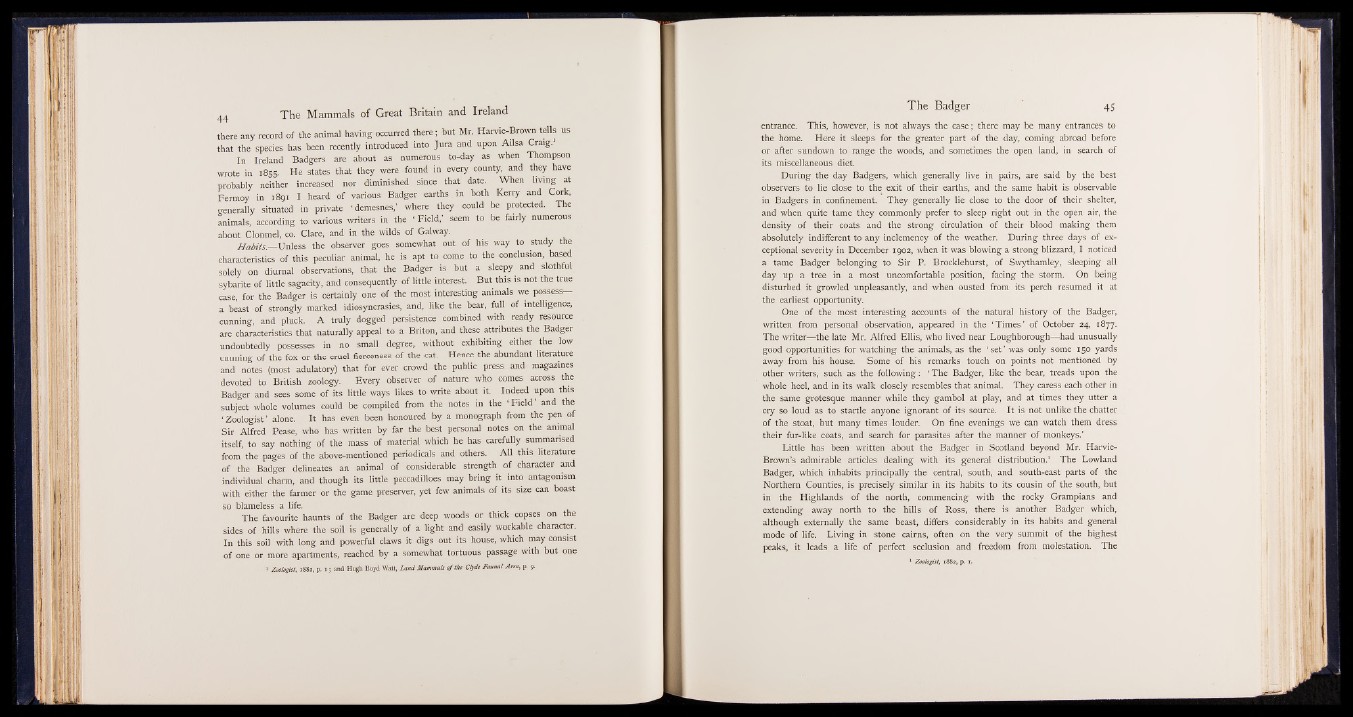
there any record of the animal having occurred there; but Mr. Harvie-Brown tells us
that the species has been recently introduced into Jura and upon Adsa Craig.1
In Ireland Badgers are about as numerous to-day as when Thompson
wrote in 1855. He states that they were found in every county, and they have
probably neither increased nor diminished since that date. When living at
Fermoy in 1891 I heard of various Badger earths, in both Kerry and Cork,
generally situated in private 'demesnes,’ where they could be protected. The
„ „ imals according to various writers in the ' Field,’ seem to be fairly numerous
about Clonmel, cd. Clare, and in the wilds of Galway.
H abits.—Unless the observer goes somewhat out H h i s way to study the
characteristics of this peculiar animal, he is apt to ,cbna_lo the conclusion, based
solely on diurnal observations, that the Badger M b iit a sleepy and slothful
sybarite of little sagacity, and consequently of little interest. But this is not the true
case, for the Badger is certainly one of the most interesting animals we possess—
a beast of strongly marked idiosyncrasies, and, like the bear, full of intelligence,
cunning, and pluck. A truly dogged persistence combined with ready resource
are characteristics that naturally appeal to a Briton, and these attributes the Badger
undoubtedly possesses: in no small degree, without exhibiting either the low
cunning of the fox or the cruel fierceness of the cat. Hence the abundant literature
and notes (most adulatory) that for ever crowd-the public press, and : magazines
devoted to British zoology. Every observer of nature who comes across the
Badger and sees some of its little ways likes to write about it. Indeed upon this
['subject whole volumes could be compiled from the notes in the ‘ Fie ld’ and the
‘ Zoologist’ alone. It has even been honoured by a monograph from the pen of
Sir Alfred Pease, who has written by far the best personal notes on the animal
itself, to say nothing of the mass of material which he has carefully summarised
from the pages of the above-mentioned periodicals and others. All this literature
of the Badger delineates an animal of considerable strength of character and
individual charm, and though its little peccadilloes may bring it into antagonism
with either the farmer or the game preserver, yet few animals of its size can boast
so blameless a life.
The favourite haunts of the Badger are deep woods or thick copses on the
sides i'of hills where the s o i l# generally of a light and easily workable character.
In this soil with long and powerful claws it digs out its house, which may consist
of one or more apartments, reached by a somewhat tortuous passage with but one
1 Zoologist, 1882, p. 1 ; and Hugh Boyd Watt, Land Mammals o f the Clyde Faunal Area, p. 9.
entrance. This, however, is not always the case; there may be many entrances to
the home. Here it sleeps for the greater part of the day, coming abroad before
or after sundown to range the woods, and sometimes the open land, in search of
its miscellaneous diet.
During the day Badgers, which generally live in pairs, are said by the best
observers to lie close to the exit of their earths, and the same habit is observable
in Badgers in confinement. They generally lie close to the door of their shelter,
and when quite tame they commonly prefer to sleep right out in the open air, the
density of their coats and the strong circulation of their blood making them
absolutely indifferent to any inclemency of the weather. During three days of exceptional
severity in December 1902, when it was blowing a strong blizzard, I noticed
a tame Badger belonging to Sir P. Brocklehurst, of Swythamley, sleeping all
day up a tree in a most uncomfortable position, facing the storm. On being
disturbed it growled unpleasantly, and when ousted from its perch resumed it at
the earliest opportunity.
One of the most interesting accounts of the natural history of the Badger,
written from personal observation, appeared in the ‘ Times’ of October 24, 1877.
The writer—the late Mr. Alfred Ellis, who lived near Loughborough—had unusually
good opportunities for watching the animals, as the ‘ set’ was only some 150 yards
away from his house. Some of his remarks touch on points not mentioned by
other writers, such as the following: ‘ The Badger, like the bear, treads upon the
whole heel, and in its walk closely resembles that animal. They caress each other in
the same grotesque manner while they gambol at play, and at times they utter a
cry so loud as to startle anyone ignorant o f its source. It is not unlike the chatter
of the stoat, but many times louder. On fine evenings we can watch them dress
their fur-like coats, and search for parasites after the manner of monkeys.’
Little has been written about the Badger in Scotland beyond Mr. Harvie-
Brown’s admirable articles dealing with its general distribution.1 The Lowland
Badger, which inhabits principally the central, south, and south-east parts of the
Northern Counties, is precisely similar in its habits to its cousin of the south, but
in the Highlands of the north, commencing with the rocky Grampians and
extending away north to the hills of Ross, there is another Badger which,
although externally the same beast, differs considerably in its habits and general
mode of life. Living in stone cairns, often on the very summit of the highest
peaks, it leads a life of perfect seclusion and freedom from molestation. The
1 Zoologist, 1882, p. 1.